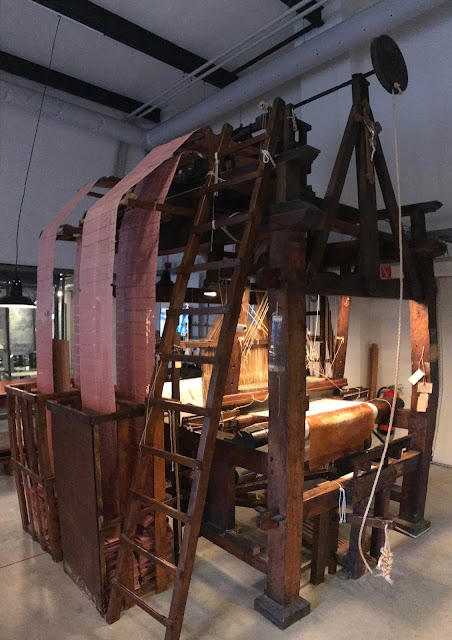These add-ons to "power looms" were invented by Joseph Marie Jacquard in the early 1800's and revolutionized weaving. It was suddenly possible to weave very intricate patterns much more quickly. Patterns were fed into the loom using a set of cards with holes - effectively punch cards. For this reason, the jacquard loom is considered a forerunner of modern computing! The systems were expensive to purchase and operate, requiring highly-skilled weavers and a lot of maintenance. But they could produce high-end damask cloth for table linens in large quantities.
Thanks to the "real" loom weaving lessons I've been taking recently, I was able to understand most of the working parts of these big devices. The patterning comes from having some threads drawn over the others for longer stretches - "overshot" - while the threads underneath continue the standard twill patterning. So the loom has two parts: the basic 4 to 8 shafts for the background twill weave, and the complex, punch-card-driven, individually-controlled string heddles behind this.
The looms were very large - with a second-storey superstructure to accomodate the punch card system:
[jacquard loom in full glory]
The operators basically stood at the loom with their bums resting on a slanted plank, so their feet could operate the levers for the shafts. In the picture above, you can see a leather apron draping down over the finished weaving (to protect it) on the lower right of the loom; the slanted wooden bum rest right in front of this. The white rope is attached to the jacquard pedal, which activates the card reader when the weaver steps on it. The holes in the cards determine which threads get lifted to make the weaving pattern, and each individual card represents one row of weaving. You can see other pedals below the loom under the weaving; these control the "background" weave.
[close up of the heddles]
In the photo above, the hundreds (thousands!) of string "heddles" hanging down with weights are the pattern heddles. Each can lift one warp thread, which runs through a small eye or loop tied in it. To the right you can see wooden frames holding more heddles; these control the background (twill) weave. There are 6 frames and each frame raises every 6th thread across the whole width of the weaving, in turn. These frames are controlled by the pedals, so that by pressing combinations of pedals, you can raise a predictable and repeating pattern of warp threads.
As you can imagine, setting up such a loom with thousands of threads is painstaking work that takes days. And if you make a mistake in threading the heddles, you'll see it in the pattern! So most looms were threaded only once, and then when the weaving was done it would be cut off carefully, leaving the heddles threaded with the remaining threads. You'd tie new threads to the remaining ones (which would still be threaded!), wind up, and start the new weaving.
You can see how fine the linen warp threads are in the following pictures. The wooden bar across the top photo is a so-called "temple"; an adjustable cross-brace with little grippy teeth at either end, used to stretch the weaving out to a specific width.
[very fine linen warp and the temple in action]
[damask in progress]
These table linens were made using a linen warp (the threads that run through the loom and the heddles) and a cotton weft (the threads doing the actual back-and-forth weaving). The complex pattern is best visible when seen at an angle; it's subtle. That's the beauty - very understated luxury!
The factory had the ability to make new punch cards, so that new designs could be made.
[punch card machine]
Once you have seen these looms, it's much easier to understand the modern ones that were in action at the museum's Textile Lab. This is where textile artists were at work, using computer-controlled looms to create strange new textiles and patterns. That's for next time!





No comments:
Post a Comment